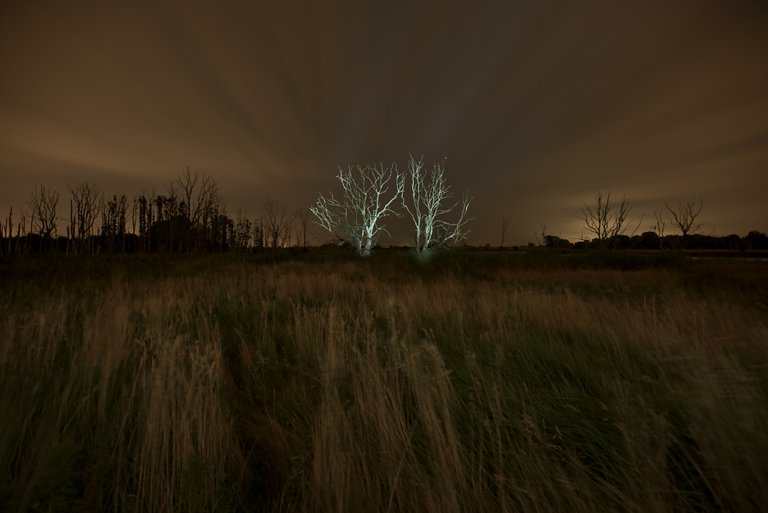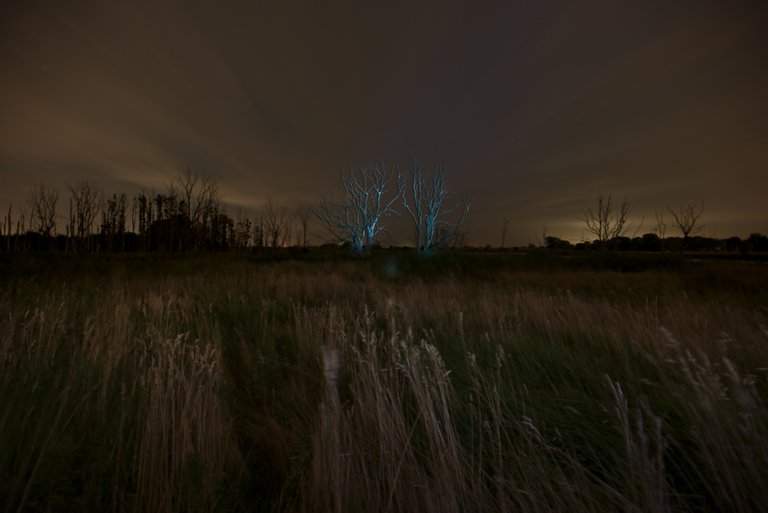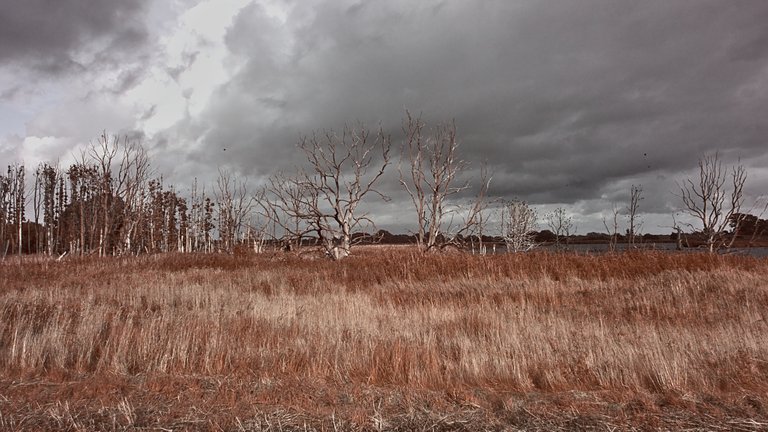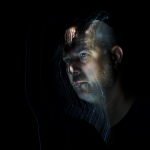THE MOOR
I discovered this small bog on the island of Rügen. At some point this part of the island was flooded with brackish water and the trees standing there died. Since then, the dead trees have been populated by hundreds of cormorants. They were obviously not too keen on me waving my torch around there at night. In any case, they didn't want to be in the picture and flew away.
Ich habe dieses kleine Moor auf der Insel Rügen entdeckt. Irgendwann wurde dieser Teil der Insel mit Brackwasser überflutet und die dort stehenden Bäume starben ab. Seitdem werden die abgestorbenen Bäume von hunderten Kormoranen bevölkert. Diese waren offensichtlich nicht so sehr begeistert, dass ich dort nachts mit der Taschenlampe rumgefuchtelt habe. Jedenfalls wollten sie keinesfalls mit ins Bild und sind davon geflogen.

📷 Nikon D750 - Nikkor 17-35/2,8 - f8 - ISO 100 - 257 seconds
Working in a bog is not all that easy or safe, certainly not at night. I had previously explored the area in daylight. I couldn't get closer than 15 metres to this tree without either the tripod with the camera or me or both sinking into the bog. I could compensate for the position of the camera with the focal length of the lens. So that was not the problem. But illuminating the tree from this great distance was a challenge. Normally I would have gone right up to the tree and illuminated it from a short distance. After aligning the camera, I took the LEP torch out of my pocket and tried to illuminate only the tree from that distance. This was anything but easy. Either I caught more or less large areas around the tree or the tree was not completely evenly lit. After five or six attempts, I opened a beer and took a short break. After that it went better. You can see the first good result of the evening above.
Die Arbeit in einem Moor ist nicht ganz so einfach und ungefährlich, schon gar nicht nachts. Ich hatte die Gegend zuvor bei Tageslicht erkundet. Näher als 15 Meter konnte ich an diesen Baum nicht heran, ohne dass entweder das Stativ mit der Kamera oder ich oder beides im Moor versinken würden. Die Position der Kamera konnte ich mit der Brennweite des Objektivs ausgleichen. Das war also nicht das Problem. Aber die Ausleuchtung des Baumes aus dieser großen Entwfernung war ein Herausforderung. Normalerweise wäre ich direkt bis an den Baum gegangen und hätte diesen aus kurzer Entfernung angleuchtet. Nachdem ich die Kamera ausgerichtet hatte holte ich die LEP Taschenlampe aus der Tasche und versuchte mit dieser aus der Entfernung nur den Baum zu beleuchten. Das war alles andere als einfach. Entweder erwischte ich mehr oder weniger große Bereiche um den Baum herum oder der Baum war nicht komplett gleichmäßig beleuchtet. Nach fünf oder sechs Versuchen machte ich mir erstmal ein Bier auf und machte eine kleine Pause. Danach lief es besser. Das erste gute Ergebnis des Abends seht ihr oben.

📷 Nikon D750 - Nikkor 17-35/2,8 - f8 - ISO 100 - 235 seconds
For the next picture I used a light blue colour filter on the LEP torch. After lighting the tree, I used the Emisar D18 to light the reeds in the foreground, as I did with the first version. However, I like the first version with the white light better. I then took some more shots, but they were all not so good.
LEP means Laser Emitted Phosphor. In simple terms, a blue laser is used to make a phosphor layer glow. The white light of the phosphor is emitted from the head of the torch via a mirror and several lenses. LEP torches have a very small beam angle. With the 500 lumens, the torch reaches a range of over 1000 metres.
Für das nächste Bild hatte ich dann ein hellblaues Farbfilter an der LEP Taschenlampe benutzt. Nachdem ich den Baum beleuchtet hatte habe ich dann mit der Emisar D18 das Schilff im Vordergrund beleuchet, wie bei der ersten Version auch. Mir gefällt die erste Version mit dem weißen Licht allerdings besser. Ich habe dann noch weitere Aufnahmen gemacht, aber die waren alle nicht so gut.
LEP bedeutet Laser Emitted Phosphor. Vereinfacht gesagt wird mit einem blauen Laser eine Phosphorschicht zum Leuchten gebracht. Das weiße Licht des Phosphors wird über einen Spiegel und mehrere Linsen aus dem Kopf der Taschenlampe emittiert. LEP Taschenlampen haben einen sehr kleinen Abstrahlwinkel. Mit den 500 Lumen erreicht die Taschenlampe eine Leuchtweite von über 1000 Metern.

This is what the scene looks like in daylight. Well, not quite, this picture is an infrared shot. In reality, the grinding was green.
So sieht die Szene bei Tageslicht aus. Also nicht so ganz, bei diesem Bild handelt es sich um eine Infrarotaufnahme. In der Realität war das Schliff grün.

And this is what it looks like from above. Where the field ends, you should not go any further if you don't want to sink up to your knees. The farmer uses almost every square inch.
Und so sieht das von oben aus. Dort wo das Feld aufhört sollte man lieber nicht weiter gehen wenn man nicht bis zu den Knien versinken will. Der Bauer nutzt fast jeden Quadratzentimeter aus.

WHAT IS LIGHT PAINTING?


LICHTKUNSTFOTO
If you like my art visit www.lichtkunstfoto.de for more Light Art Photography and informations about Light Painting. Join me on Flickr Twitter

For more great Light Art Photography, Light Painting and inspiration check these light painters: @marlasinger666 @fadetoblack @fastchrisuk @dawnoner @oddballgraphics @martbarras @stepko @rod.evans.visual @yo-hoho @maxpateau @gunnarheilmann @neilru75 @maximepateau @ryuslightworks @lightstabeu

WE ARE LIGHT PAINTERS

To help and support the LightPainters community here on Hive I would appreciate your delegation of HivePower. Any amount is appreciated. It does not require much to get started, we are happy for any gesture. @lightpainters
How to delegate?
Delegate 50HivePower, [50HP]
Delegate 250HivePower, [250HP]
Delegate 500HivePower, [500HP]
Delegate 1000HivePower, [1000HP]
All the Hive Power will help to upvote the artist's contribution as part of the LightPainters community.
Very cool my friend, it's good to have the dercription of a special place!! Big up 🙏🙏🙏
Thanks mate 😊
@lichtkunstfoto Very appreciating your efforts to get this picture, being in the swamp at night it's not easy and a little dangerous. Your hard work paid off in the first line picture, I really liked it. Thank you for sharing and telling the tutorial on the use of light in photography, I learned a lot from this post.
I am glad you like it and i am happy if my post is helpful for you.
@lichtkunstfoto I will continue to learn with your tutorial, and I make sure it will get results that make me satisfied, 😁
Well done, cool to see those "highlighted" trees 👌🏻❗️
Thanks 🙂
More good stuff Sven mate.
Thanks 😊
Great work, really like the spookiness of it. I can imagine that this wasn't an easy shot to set up but well worth it!
Thanks
The rewards earned on this comment will go directly to the person sharing the post on Twitter as long as they are registered with @poshtoken. Sign up at https://hiveposh.com.
Really good shot and article, thank you for sharing this 👍